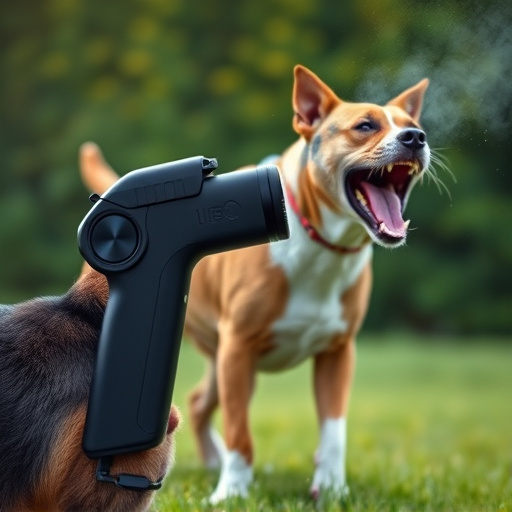Mail carriers in high-risk areas may carry mace spray for self-defense, but its use is regulated and requires understanding local laws. If a dog comes into contact with pepper spray, swiftly move them to a well-ventilated area and wash the spray off using warm water, mild soap, and a soft cloth. The ethical concerns surrounding pepper spray on dogs highlight the need for carrier training in de-escalation tactics and exploring alternative dispute resolution methods. Non-lethal personal protection equipment like specialized pepper spray, high-visibility gear, and sturdy batons offer safer alternatives with visual deterrents. Staying informed about local laws ensures carriers make responsible choices that protect them and maintain the postal service's public image.
“In today’s diverse and sometimes unpredictable urban environments, mail carriers face unique challenges. This article delves into an important topic: the use of mace spray as a self-defense mechanism for postal workers, focusing on its legal status and ethical implications. We explore ‘mace spray mail carrier approved’ considerations, including how to safely wash pepper spray off a dog’s fur in case of accidental exposure. Additionally, alternative self-defense solutions are presented, offering a comprehensive guide for mail carriers to prioritize safety.”
- Understanding Mace Spray and Its Legal Status for Mail Carriers
- Safety Measures: How to Wash Pepper Spray Off a Dog's Fur
- The Impact of Pepper Spray on Dogs and Ethical Considerations
- Alternative Solutions for Mail Carrier Self-Defense
Understanding Mace Spray and Its Legal Status for Mail Carriers
Mace spray, also known as pepper spray, is a powerful irritant designed to temporarily disable and disorient individuals by targeting their eyes, nose, and respiratory system. It’s important for mail carriers to understand its legal status in their line of work. In many jurisdictions, carrying mace spray is permitted for self-defense purposes, especially when delivering mail in potentially high-risk areas. However, there are strict regulations regarding its use; it must be used only as a last resort and in response to an immediate threat.
Mail carriers who choose to carry mace spray should familiarize themselves with local laws and guidelines. This includes knowing how to properly wash pepper spray off their clothing and especially dog fur if they have service animals, as pets can also be affected by the spray. Responsible use involves ensuring that the spray doesn’t pose a risk to innocent individuals or animals nearby. Proper training is crucial in understanding when and how to deploy mace spray safely and effectively while adhering to legal boundaries.
Safety Measures: How to Wash Pepper Spray Off a Dog's Fur
If your dog has been in contact with pepper spray, it’s crucial to act swiftly and safely to wash pepper spray off their fur. Start by moving your dog to a well-ventilated area away from any sources of the spray. Next, gather essential supplies: warm water, mild soap (like baby shampoo), and a soft cloth or sponge. Wet your dog’s fur thoroughly with warm water, ensuring the solution reaches all affected areas. Gently apply the mild soap, creating a lather, focusing on soapy areas for about 10 seconds. Rinse thoroughly with warm water until no residue remains, making sure to remove any soap from their eyes and nose. Dry them gently using a soft towel or cloth.
Remember, handling pepper spray is delicate, and the process requires caution for both your safety and that of your furry friend. Always wear protective gear if you’re decontaminating an area or a person exposed to pepper spray.
The Impact of Pepper Spray on Dogs and Ethical Considerations
Pepper spray, while effective for personal protection, can have significant impacts on animals, especially dogs. When a mail carrier uses pepper spray on a dog, it can lead to immediate and severe physical and psychological effects. The spray irritates the eyes, nose, and throat, causing temporary blindness, coughing, and difficulty breathing. In some cases, it may even induce panic or aggressive behavior in dogs due to the pain and disorientation.
Ethical considerations arise when discussing the use of pepper spray on animals. Mail carriers must be trained to recognize non-threatening situations and de-escalate instead of resorting to force. Promptly washing pepper spray off a dog’s fur is crucial to minimize discomfort and potential long-term health effects. It’s essential for both public safety and animal welfare that such incidents are rare, and alternative methods of dispute resolution are explored whenever possible.
Alternative Solutions for Mail Carrier Self-Defense
Mail carriers, like any professional in a public-facing role, should prioritize their safety above all else. While mace spray is one option for self-defense, it’s not always ideal, especially when dealing with animals or sensitive environments. An alternative solution could be investing in non-lethal personal protection equipment specifically designed for outdoor work. For instance, specialized pepper spray formulated to wash off easily is a humane and effective deterrent against potential threats like aggressive dogs. These sprays are tailored to adhere to fur, clothing, or skin without causing long-term harm.
Additionally, carrying a sturdy batons or using high-visibility reflective gear can serve as visual deterrents, while also offering physical protection in case of an attack. It’s essential for mail carriers to stay informed about local laws and regulations regarding self-defense tools, ensuring they select options that align with their legal rights and responsibilities. Prioritizing safety through well-informed decisions not only protects the carrier but helps maintain a positive public image for the postal service.
In light of the above discussions, it’s clear that while mace spray can be a useful tool for mail carriers facing potentially dangerous situations, its application comes with significant ethical and safety considerations, especially regarding its impact on dogs. Mail carriers should prioritize non-lethal alternatives and learn proper decontamination methods, such as how to effectively wash pepper spray off a dog’s fur, to ensure the safety of both themselves and animals they encounter during their routes. Additionally, ongoing training in self-defense tactics that avoid harmful chemicals can help carriers protect themselves while fostering positive interactions with the communities they serve.
